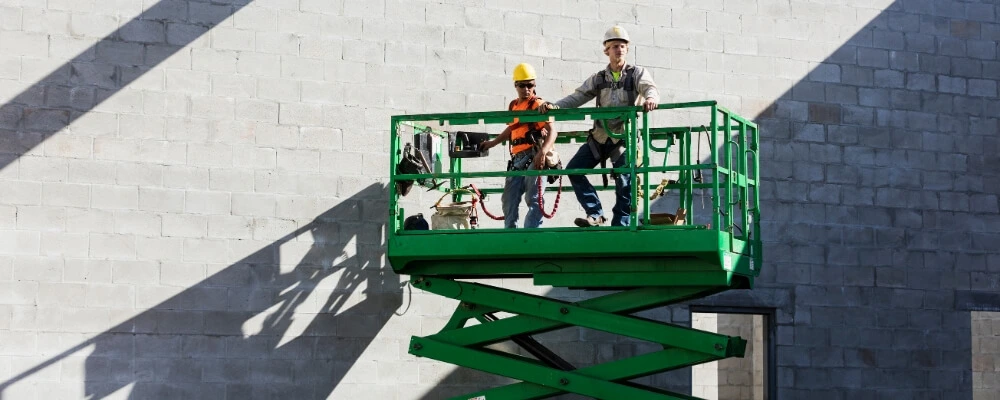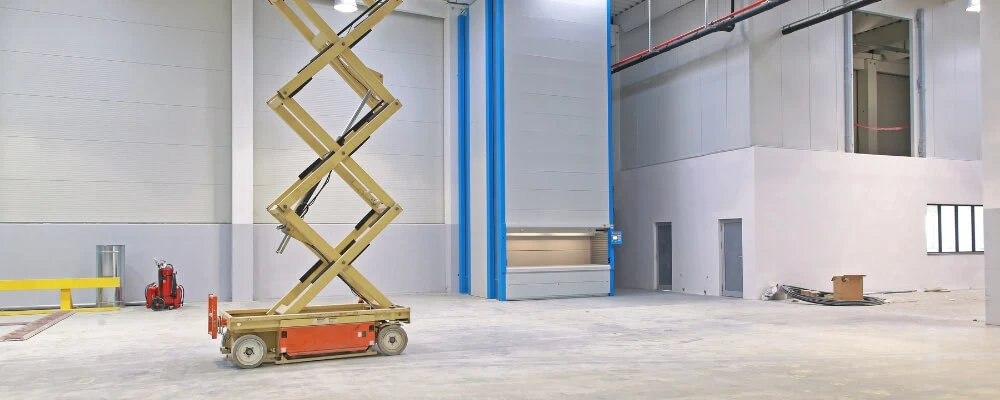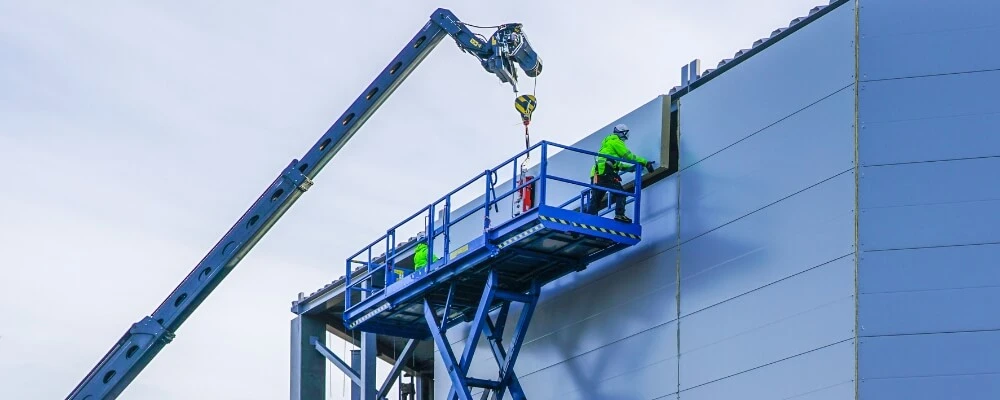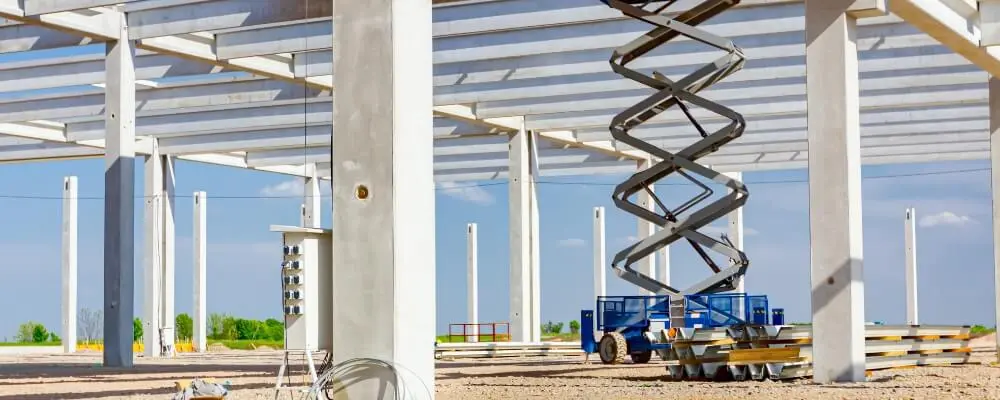In construction and maintenance, scissor lifts have revolutionized how we approach tasks at elevation, offering both flexibility and efficiency. However, with this innovation comes a responsibility to prioritize safety. A lapse in caution can transform this versatile tool into a potential hazard. While these machines are designed with user safety in mind, accidents can occur, often with devastating consequences. This is why understanding and implementing proper safety measures is paramount.
This blog delves deep into the ’10 Key Safety Rules For Scissor Lift Fall Protection.’ Whether you’re a seasoned operator, a site manager, or someone new to the industry, these rules serve as a crucial refresher to ensure that every elevated task is completed without compromising safety. Join us as we elevate your safety knowledge to new heights.
What is Scissor Lift And Its Use
A scissor lift is a type of mobile elevating work platform (MEWP) that primarily moves vertically. It owes its name to the scissor-like mechanism it employs: the crisscrossing metal supports, known as a pantograph or scissor mechanism, which elongate as the platform is raised and compress as it is lowered.
Uses of Scissor Lifts:
- Construction Sites: Scissor lifts provide workers with a safe platform to perform tasks at height, such as installing overhead structures, painting, or maintenance.
- Warehouse Management: They offer a way to access high shelves, conduct stock takes, or handle materials stored at height.
- Building Maintenance: Scissor lifts are used for tasks like window cleaning, exterior painting, or repairs on tall structures.
- Retail and Inventory: Large retail establishments might use them to arrange stock, change displays, or manage inventory in high storage areas.
- Public Works: Scissor lifts are employed for tasks like changing street lights, trimming trees, or performing maintenance on elevated public structures.
- Events and Entertainment: In the film and television industry, they are used for positioning lights, cameras, or rigging. They’re also used in setting up stages for events.
- Transportation: Some airports use scissor lifts to facilitate the loading and unloading of cargo from aircraft.
In essence, any task that requires safe and stable elevation on a vertical plane can benefit from using a scissor lift. It’s important to note that while scissor lifts are incredibly versatile, they are designed to move vertically and do not offer the same range of movement as other MEWPs like boom lifts or cherry pickers. Proper training and safety precautions are crucial when using them to ensure the safety of the operator and those around them.

The Hazards and Dangers of Scissor Lifts
Like all heavy equipment, scissors lifts present a range of potential hazards if not operated or maintained correctly. These dangers are crucial for operators, maintenance personnel, and bystanders. Here’s a comprehensive overview of the hazards and dangers associated with scissor lifts:
- Falls from Height: One of the most evident risks associated with scissor lifts is the potential for falls. While guardrails typically serve as the primary fall protection on scissor lifts, they may not be foolproof. There can be situations where a worker is thrown off balance or a guardrail fails, leading to a fall from a significant height.
- Tip-Overs: Uneven or unstable ground, reaching out too far from the platform, or surpassing the lift’s load capacity can cause the machine to tip over, endangering not only the operator but also nearby workers.
- Electrocution: A common hazard when working at height is coming into contact with overhead power lines. Accidentally maneuvering the lift too close to or into a power line can result in electrocution, potentially causing serious injury or death.
- Entrapment: Workers can become entrapped between the scissor lift and nearby obstructions, such as beams or other structures. This can lead to crushing injuries or asphyxiation if a worker is pinned and cannot breathe.
- Mechanical Malfunctions: Scissor lifts are complex machines with various components that can fail. Hydraulic leaks, for instance, can lead to sudden platform collapses. Brake failures might result in uncontrolled movement of the lift.
- Collisions: If the lift is moved without proper visibility or spotters, it can collide with other equipment, structures, or pedestrians, leading to injury or property damage.
- Wind and Weather Conditions: Operating a scissor lift in adverse weather conditions, particularly high winds, can destabilize the platform or make handling difficult, increasing the risk of accidents.
- Lack of Training: Improper operation due to insufficient training or familiarity with the specific scissor lift model can lead to numerous hazards, from improper platform elevation to unsafe machine driving.
- Unauthorized Alterations: Modifying a scissor lift without manufacturer approval can introduce unpredictable behavior in the machine or disable safety features, leading to increased risks during operation.
- Ground Conditions: Soft ground, concealed holes, or uneven terrain can cause the lift to become unstable or tip. Using scissor lifts on unassessed or unsuitable terrain is a significant hazard.
- Overloading: Surpassing the lift’s weight capacity by overloading it with equipment or too many people can lead to structural failures or tip-overs.
- Failure to Conduct Inspections: Not performing routine checks or neglecting maintenance can mean that wear and tear or mechanical issues go unnoticed, making the machine unsafe for operation.
Recognizing and understanding these hazards is the first step toward ensuring a safe work environment. Proper training, regular maintenance, and adherence to safety protocols can mitigate these risks and ensure the safe operation of scissor lifts.

10 Key Safety Rules For Scissor Lift Fall Protection
Safety is paramount when working with machinery, especially when heights are involved. Here are ten essential safety rules for scissor lift fall protection:
1. Proper Training
Operating a scissor lift isn’t as straightforward as one might assume. Each scissor lift model can differ significantly regarding controls, capacities, and operational nuances. For this reason, only those individuals who have been thoroughly trained and certified should be permitted to operate them. This training ensures that operators understand the intricacies of the specific scissor lift model, from its weight limits to its control mechanisms.
Moreover, training typically encompasses safety protocols, ensuring the operator knows potential hazards and how to handle them. Certification, conversely, is a testament that the individual has achieved the necessary competence and understanding to operate the lift safely.
2. Regular Inspections
The health of machinery is just as crucial as the competence of its operator. Before utilizing a scissor lift, a comprehensive inspection should be conducted. This is not just a cursory glance; it involves assessing the machinery for visible signs of wear, damage, or malfunctions. The guardrails, for instance, play a critical role in preventing falls; thus, confirming their firm attachment and pristine condition is paramount.
The same diligence applies to the controls – they must be tested to ensure they are responsive and operational. A lift in poor condition is a ticking time bomb, so this step is non-negotiable.
3. Use Guardrails
Guardrails serve as the primary defense against the dangers of falling. Their role is to create a barrier that ensures individuals working on the platform remain within its confines, even if they lose their balance or are subject to sudden lift movements. It’s not just about having guardrails in place, though. Their condition is equally vital.
Damaged or weak guardrails can give way under pressure, defeating their purpose. Therefore, ensuring that the guardrails are in peak condition and securely attached is essential. Any compromise here significantly elevates the risk of accidents.
4. Personal Fall Arrest System (PFAS)
In some scenarios, merely having guardrails isn’t enough. There are instances, either dictated by the specific job at hand or an employer’s enhanced safety protocols, where additional fall protection is necessary. This is where the Personal Fall Arrest System comes into play. A PFAS typically includes a full-body harness worn by the individual, which is then connected to the lift via a lanyard. This lanyard attaches to a specially designated anchor point on the lift.
So, even if someone falls, the PFAS arrests that fall, ensuring the individual doesn’t hit the ground. It’s an additional layer of safety that can, quite literally, be a lifesaver.

5. Stable Ground
The foundation on which a scissor lift operates plays a critical role in its stability. An uneven, soft, or inclined surface can cause the lift to become unstable, potentially leading to tipping over. The consequences of such an occurrence are severe, given the heights these lifts can achieve. It’s not just about ensuring the ground is stable when the lift is stationary; operators must also be vigilant, avoiding terrains that could compromise stability.
Proper assessment of the operating environment, therefore, becomes crucial. Ensuring the lift is on solid, level ground is one of the foundational safety measures operators must adhere to.
6. Beware of Overhead Hazards
Elevating a scissor lift platform can inadvertently introduce the operator to various overhead hazards. These hazards might range from fixed structures like beams and ceilings to more perilous obstacles like live electrical wires. Overlooking these can lead to dangerous collisions or electrocutions, especially when close to high-voltage power lines.
Therefore, it’s essential for operators to always conduct a comprehensive overhead scan before raising the platform. It’s about identifying these obstructions and maintaining a safe and regulated distance from them, especially for electrical lines, to prevent potential accidents.
7. Stay Within Load Limits
Every scissor lift has a specific load capacity determined by its design and engineering. This capacity isn’t just a suggestion but a strict limit that ensures the safety and stability of the equipment. Overloading a scissor lift, whether by cramming it with too much equipment or having too many personnel on board, can seriously compromise its balance.
Such an imbalance can lead to the lift becoming unstable, swaying, or in extreme cases, tipping over. It’s vital for operators to be fully aware of their specific lift’s load limit and to ensure that under no circumstance is this limit breached.
8. No Unapproved Alterations
Scissor lifts are intricately designed machinery; every part serves a specific purpose. As such, making any alterations or modifications without the explicit approval of the manufacturer can compromise the lift’s safety. Any unauthorized change can have unintended consequences, whether attempting to add an attachment, modifying the platform size, or even seemingly minor adjustments to the guardrails.
Such alterations can make the lift behave unpredictably or even make certain safety features inoperative. Operators and technicians should always resist the temptation to “improve” or “modify” the lift without the necessary clearances.

9. Maintain Communication
Given the elevated positions scissor lifts can reach, clear lines of communication between the operator and ground personnel are imperative. An operator might need assistance, or there might be an impending hazard that ground personnel can see, but the operator can’t.
Reliable communication tools, radios, whistles, or other signaling devices ensure the operator can relay information or call for help. It’s not just about having the tools; regular checks to ensure they’re in working order and protocols for using them efficiently are equally crucial.
10. Emergency Plans
While every safety measure aims to prevent emergencies, it’s equally vital to be prepared for when they do happen. Knowing the emergency procedures is non-negotiable for every scissor lift operator. This includes understanding how to manually lower the platform if there’s a malfunction with the lift’s controls.
But it’s not just about the machinery; operators should also be prepared for personal emergencies. Whether it’s someone falling, a medical emergency on the platform, or any other unforeseen circumstance, having a robust and rehearsed emergency response plan is essential. Such preparedness ensures that, even in the face of adversity, the response is swift, effective, and minimizes potential harm.
Conclusion
Navigating the heights with scissor lifts demands skill and an unwavering commitment to safety. As we’ve explored in our discussion on the ’10 Key Safety Rules For Scissor Lift Fall Protection,’ every rule is a lifeline, a preventative measure designed to shield workers from potential mishaps. While the lift simplifies complex tasks, we must respect and recognize the risks of its operation.
By internalizing and implementing these safety protocols, we protect individual workers and foster a safety culture that benefits entire teams and projects. Let’s remember that in the world of elevation work, staying grounded in safety practices ensures we can confidently rise to every challenge. Always prioritize safety — because every life matters and every accident is one too many.

